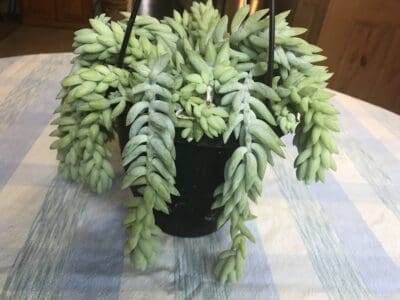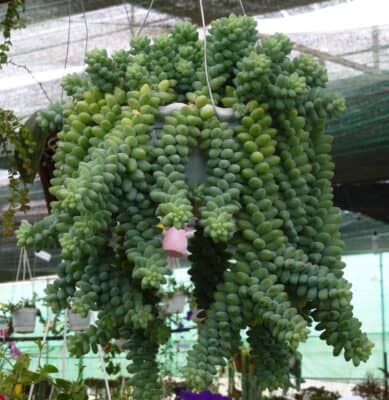This post contains affiliate links.
Now that I have finally bought my first donkey’s tail succulent, I decided to learn what I could about this trailing beauty and one of my questions was “How fast do Donkey’s tail plants grow? I’ve seen those pictures of lusciously thick Donkey tail plants in hanging baskets and wanted to get the same results with my plant as soon as possible. My challenge was that I would be growing my plant indoors in an environment that is drier in the Winter than their native habitat. (Summers are humid here, but winters are dry). So I needed all the tips I could get to start out right and this is what I found out about them:
Donkey’s Tails are slow-growing plants, but with patience, they will reach full maturity in about 6 years. They generally grow about 24 inches in length but can get as long as 4 feet in length if the conditions are right.

Now that I know how long they can grow if all the conditions are correct, as well as how long it takes for them to reach maturity, I now need to find out if I can do anything to keep them healthy during this process so they can reach their best potential growth in the shortest time possible.
How to Grow Donkey’s Tail Fast: 8 Tips for Better Growth

I’ve seen some donkey’s tail plants that have lost leaves. These leaves have fallen off over time, leaving stems that aren’t as full and healthy as they should have been — and I wanted to avoid that with my plant, if possible. I also want to learn what to do if they lose leaves. Is there anything I can do to correct the problem? Can I do anything to encourage better growth of my plant?
These were just some of the questions I had about my new succulent and the following 8 tips on how to care for Donkey’s tail succulents answer most of those questions.
1. Donkey’s Tail Growth and Natural Environment
The first tip is very important for any type of plant – we need to understand more about how they grow in their native habitat in order to know what their needs are. Doing so helps us better understand how they grow, what type of environment they need to grow, and what can harm or hinder their growth.
The best way to encourage them to grow to their fullest potential is to mimic the natural conditions of their original environment as much as possible and that includes their requirements for light, water, soil, and temperature.
Donkey’s Tail, Sedum morganianum, is a succulent in the genus called sedum. Sedums are evergreen perennials and tend to sprawl on the ground or over rocks. Donkey’s tails are native to Mexico and are drought resistant.
Their tear-dropped shaped leaves are green with a slight hint of blue and grow in dense clusters around each of the plant’s trailing stems, giving the appearance of braided ropes. Sometimes the leaves also have a powdery “bloom” coating. The leaves are fragile and will fall off if not handled with care.
These plants like warm weather, 65-75 degrees F, but can also (briefly) tolerate temperatures as low as 40 degrees F. They need plenty of sunshine, but also need protection from the sun during the hottest times of the day. Their leaves will turn yellow in color when exposed to too much sun.
2. Light Requirements For a Healthy Donkey’s Tail
Donkey’s Tail succulents grow best in partial sunshine or bright indirect light. They thrive when they get lots of sunshine – while still being protected from the sun during the hottest time of the day. Usually, a spot with lots of morning sunshine will work as long as they have protection from the afternoon sun and heat.
Since I’m growing my plant indoors, – and my goal is for it to grow as fast as it can – that means I need to place it in the sunniest window of my house so it will get as much sun as possible, while keeping in mind that it should still be protected from the harshest afternoon sun and heat. I plan to add artificial lighting for the times of the year when my home doesn’t have sufficient natural lighting.
If your house is like mine, then you will need to supplement light for your Donkey’s tail plant and Amazon has this one . I like the fact that the light is full spectrum
3. Water Needs For a Donkey’s Tail Plant
These plants require plenty of water to keep the leaves plump, but overwatering can also be a problem. They should be watered only when the top inch to two inches are dry; while also being careful to not let the soil get bone dry.
That usually means the plants should be watered once a week during the growing season, which is during Spring and Summer. In the winter, they would only need to be watered about every two weeks. Of course, the type of pot used will make a difference too. Terra cotta pots will allow the soil to dry out faster than other types of pots such as plastic, or glazed ceramic pots. So they may need to be watered more often if they are in terra cotta pots, and less often in plastic pots.
Note: Avoid splashing the leaves when watering and use room temperature water, not cold water from the tap. In fact, it would be best to avoid watering any of your plants with tap water containing chlorine or chloramine treatment.
One way to ensure your Donkey’s Tail’s moisture levels are good is by using a moisture meter. They aren’t very complicated or hard to use and they take the guesswork out of knowing when your plants need to be watered.
This article explains how these meters work and this one explains how to use them to measure your soil’s moisture
4. The Best Soil is a Well-draining Soil For Donkey’s Tails
Use sandy or gritty soil such as a cactus or succulent soil mix from a local nursery. You can also make your own soil as we described in this article.
But if you want to buy a good quality mix, I recommend this one from Amazon by Bonsai Jack. It is a gritty mixture that works very well with my cactus and succulent plants.
I have also used this one from Miracle-gro but only after amending it with perlite to improve the drainage of the soil. This one is more economical, even after adding in the extra cost of the added perlite.
Note: You want to use well-draining soil with a pH that is neutral to a slightly alkaline pH. Ref: https://plants.ces.ncsu.edu/plants/sedum-morganianum/
You don’t want the roots to sit in water since that will cause root rot to set in, so make sure your pot has drainage holes to let the excess water drain out after watering.
5. Ideal Temperature and Humidity Levels for Donkey’s Tails
As we learned earlier, these plants need warm temperatures to thrive, (65-75 degrees F). They don’t do very well in extreme heat or extreme cold. So they will do very well in normal temperature-controlled conditions that are usually found indoors.
They like high humidity levels like those found in their natural habitat but will tolerate slightly lower levels like what is often found inside a home. This might be a problem in the wintertime since many heated homes have very low humidity levels. You can increase the humidity levels by placing a humidifier near your plants. If you are interested in getting a humidifier, you can check this one out here.
You can also surround your donkey’s tail with other plants to create a more humid environment for your plant.
6. Fertilizing Donkey’s Tails (Optional)
You don’t need to fertilize your donkey’s tail plant. If you decide to fertilize it, don’t fertilize it more than once a month during the spring and summer (the growing season) and not at all during the winter. Also, it would be best to use a diluted fertilizer and not full strength.
7. Handle Donkey’s Tail With Care – They are Fragile
Donkey’s tails are considered by some to be a tricky plant to grow. This is mainly because they can be easily overwatered, but also because they are fragile and will lose their leaves if not handled correctly.
The leaves will easily fall off when bumped, moved, or handled. This will leave you with a plant with bare patches on its stems, and these bare patches won’t fill in again with new leaves.
With this in mind, it’s best to keep these plants away from areas of traffic in your home. Find a spot for them in your home where they can be enjoyed, but where they’re not in danger of being bumped or damaged.
8. Prune if or When Foliage Gets Thin
You don’t need to prune your Donkey’s tail plant, but If by chance, it does lose its leaves and you want to start over with new healthy strings of growth, you can prune the stems. Pruning the stems will encourage the strings to branch out and will give the plant a fuller look.
If you want to propagate new plants from your prunings, check out this article on how to propagate leaves.
When Does Donkey’s Tail Flower?
Once you have an established plant growing in your home, and you’re doing all you can to keep it healthy, you might start to wonder if your Donkey’s tail will eventually flower for you.
Donkey’s Tails don’t bloom very often when grown indoors, but when they do, they bloom during the growing season, which is spring and summer. They form in clusters of star-shaped flowers at the ends of the longer stems (at least 10” or longer).
These flowers are often red, pink, yellow, or lavender but also come in a range of other colors too.
Donkey’s tail vs burro’s What’s the Difference

While doing research on my new Donkey’s tail plant, I found out that people often also call it Burro’s tail, interchangeably. So I looked into the matter a little closer.
Is Donkey’s tail and Burro’s tail the same plant or are they different plants that just look a lot alike? If they are not, what’s the difference between Donkey’s tail and Burro’s tail?
There are some differences between Donkey’s tail and Burro’s tail. Donkey’s tail, sedum morganianum, can be identified by its tear dropped shaped leaves (The leaves are pointy at the ends). Burro’s tail, sedum morganianum, also sometimes called Burrito has leaves that are more rounded in shape than those of the Donkey’s tail.
Burro’s tail is considered to be a variety of Donkey’s tail. Other than the shape of the leaves, the two plants are pretty much identical.
This post was written for cactus-central.com and is not permitted to be used on other sites.

